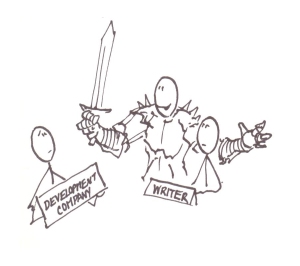Confused about what kind of game writer you want? You’re not alone! The game industry constantly struggles with titles in every department, and writing is no exception. When looking for a game writer, story designer, narrative designer, dialog writer, etc., make sure you’re looking for the right kind. For this series, we teamed up with Chris Avellone, writer and co-founder of Obsidian Entertainment, who offered up his characteristic artwork for this issue.
Writer/Co-Founder

This writer is so good s/he started a company to share the shiny goodness
Known for: Great writing, good management, and the ability to walk on water
Narrative Designer
Writer who knows the ultimate truth that game story doesn’t begin and end with the written word
Known for: Using a holistic approach to game development, and having it all figured out 😉
Narrative Designer
This type of ND acts as champion for a game writer’s work within a company, especially if game writer works on contract.
Known for: Diplomacy, good eye for great writers (like us!)
Content Designer

Someone who works on staff, writes some storylines, then implements them into the game with tools. Someone who will rise in the design department, rather than being relegated to the “writer ghetto” that exists on some staffs
Known for: Having a career path, a pile of story ideas, and a secret desire to shed the designer title and be a WRITER FOREVER!
All done? Not so fast… Next week we’ll put up more game writers, including the game writer vs. game writer confusion. Subscribe to make sure you’re getting the right writer!
Found this blog entry useful? Click here to e-mail it to someone!



 Story vs. Story: Redefining Narrative and Player Engagement in MMOs
Story vs. Story: Redefining Narrative and Player Engagement in MMOs